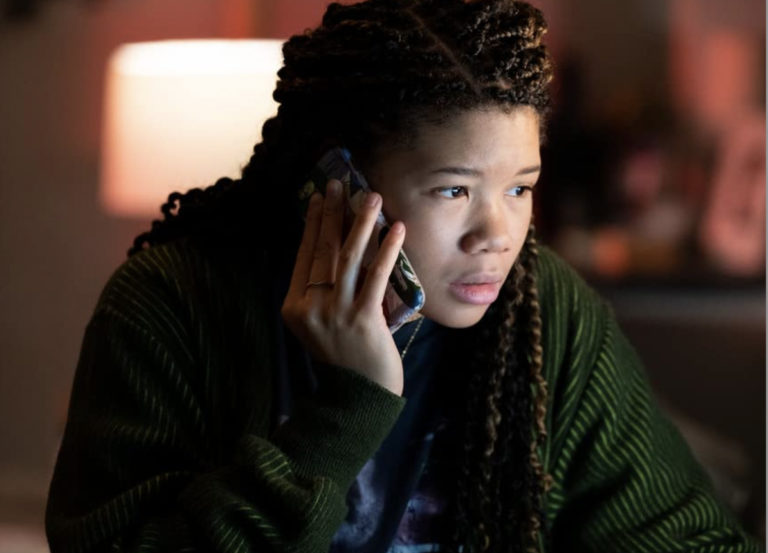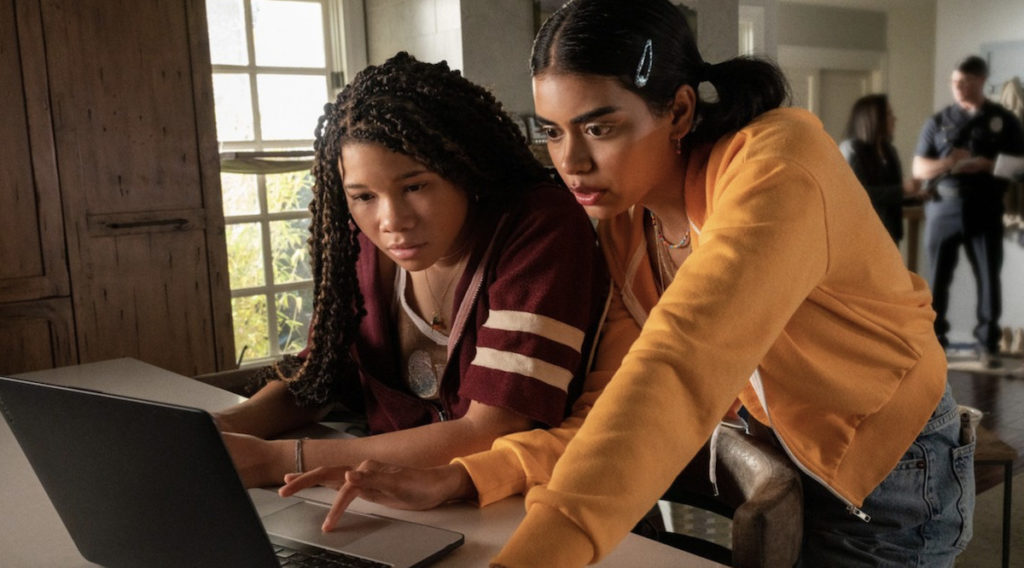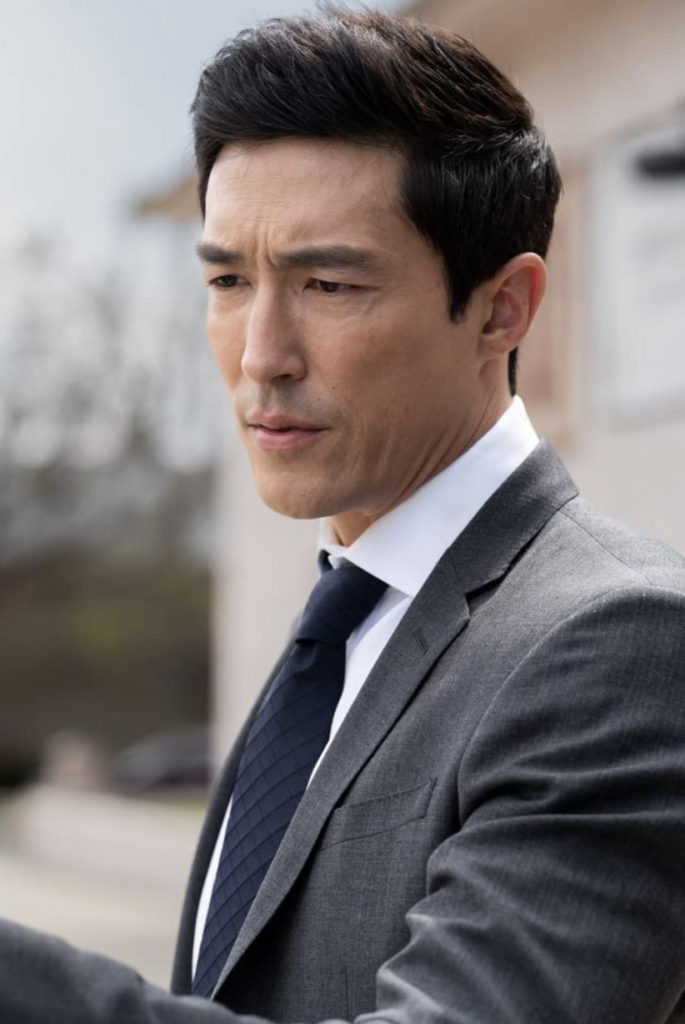
Synopsis : When her mother (Nia Long) disappears while on vacation in Colombia with her new boyfriend, June’s (Storm Reid) search for answers is hindered by international red tape. Stuck thousands of miles away in Los Angeles, June creatively uses all the latest technology at her fingertips to try and find her before it’s too late. But as she digs deeper, her digital sleuthing raises more questions than answers… and when June unravels secrets about her mom, she discovers that she never really knew her at all.
Rating: PG-13 (Teen Drinking|Some Strong Violence|Language|Thematic Material)
Genre: Mystery & Thriller
Original Language: English
Director: Will Merrick, Nicholas D. Johnson
Producer: Natalie Qasabian, Sev Ohanian, Aneesh Chaganty
Writer: Nicholas D. Johnson, Will Merrick
Release Date (Theaters): Jan 20, 2023 Wide
Runtime: 1h 51m
Distributor: Screen Gems

Exclusive Interview with Co-Writer/Producer Sev Ohanian and Producer Natalie Qasabian
Q: So, Sev and Natalie, I know you two are a husband-wife duo, but how did you two meet Aneesh Chaganty and make the film “Searching” [2018]? Was it Google Glass’ first collaboration?
SO: Yes! You know your history, man. So myself, Natalie and Aneesh, we all went to USC [University of Southern California] for film school. I was a graduate student, and they were undergrad students. I ended up as Aneesh’s TA [Teacher’s Assistant] in his class. I was so struck by how brilliant he was, his creativity, he has a presence. If you have ever met Aneesh, you know he has this amazing energy.
I suggested we work together and we wrote a movie, “I Should Never Show My Face”. It was a campus event, a career event, where Natalie and I met. And the moment we saw each other, she fell desperately in love with me. It was immediate. And I told her, “Hey, I’ve written a script. Can I pitch you the script?” It was a movie that I had written with Aneesh. I started pitching Natalie the script —
NQ: — and halfway through, I cut him off. [laughs] Like I just did! And I pitched him what I thought was the end of his story, and to my surprise, I was right. And then he was like, “Now you have to read the script.” So —
SO: So that’s how we had a meeting and ended up becoming partners, but in a lot of ways, it’s also thanks to Aneesh. Because if I hadn’t written the script with Aneesh, I don’t know if we would have ever had that interaction. That was very rude, by the way.
Ever since then the three of us have been very close collaborators. And yet Google Glass was our first big project together, and that led to us making “Searching” and everything else since.
Q: Sev, you also previously produced the film “Fruitvale Station” [2013] which won the top prize at Sundance, and you worked with director Andrew Bujalski for “Results” [2015] and Clea DuVall who directed “The Intervention” [2016]. And Natalie, you produced the film “All About Nina” [2018] and worked with the Duplass brothers. You both have a very keen eye to find talented directors and actors, what do you look for when you assemble the team?
NQ: That’s a great question. I think one thing we share and we both look for, honestly, is passion. The thing that probably all the directors we’ve worked with had in common, especially Aneesh — and Will [Merrick] and Nick [Johnson] [co-directors] — is a deep, deep passion. We put a lot of work and love into these [films] so you want to find a partner that’s equally excited, and shares the same tastes in material.
SO: Yeah, passion is exactly right. You want someone who will care, because the last thing that we would ever want to do is to work with someone who sees it just as a day job. There’s so many hours that go into this, and so much energy and stress, that you need to be working with people who are just as passionate and just as much care about what you’re making. Because at the end of the day, that passion, energy, I believe, is going to reflect in the finished product for audiences to watch.
Q: Speaking of talent, the performance by Storm Reid was really impressive. What was the element that surprised you most to cast her, and what kind of things surprised you about the performance on the set?
NQ: We knew we wanted a strong actor for this role. Obviously, they have to carry the film much like John Cho did in “Searching”. We knew we wanted a young lead. We didn’t have anyone specific in mind for this, any specific culture, background, any of that. So we went far and wide with the search.
When Storm came to our attention, and it became clear that she was interested in doing the movie, honestly we were so excited and so flattered. We’re all fans of her work, and we’ve all seen her grow up [on] screen. She came in and just blew us away: the command that she has, and the screen presence, but also the ability to do some of the more technical stuff in this movie. She balanced that so well. She’s a really relatable character because she brought this authenticity to the role that I think really comes through.

Q: You are very adamant about casting with diversity in the film “Searching”. What things did you carefully approach this time, such as the interracial relationship between husband and wife?
SO: Absolutely. It is one of the unofficial rules any time we make movies together. We also made a movie called “Run” that Aneesh directed. We cast a young actress who uses a wheelchair. It was, for us, never a question.
With “Missing”, our approach was just like with “Searching”: never having to ask the question of “why”. It’s never about why we need to cast an American family, or a black family, or a family with disabilities. It’s always a question of “why not?” Because for us, inclusion is best represented when you normalize representation.
Then a movie like “Missing”, which is about a very universal type of story of somebody looking for a missing loved one. If we happen to cast a diverse cast, it only normalizes that in the media that we watch, and hopefully that can affect more and more change. We were very intentional in who we cast in every role. We wanted to put an interracial relationship on screen because you don’t see enough of that, especially in this order. We’re lucky that all of our partners, from our directors of course, to Sony who was so supportive — everyone across the entire board understood what we were trying to do and they helped us make it possible.
Q: Why did you decide to just produce this time? You have enough trust in directors Nicholas D. Johnson and Will Merrick, because they were editors of “Searching” and “Run”.
SO: We do trust them immensely, and it’s really because the five of us spent so much time making “Searching”, literally in a tiny room — actually smaller than the room we’re in right now. That’s how close we were.
When it came time for making “Missing” — I don’t know if you know this, but — Aneesh and I did write the outline. So we broke the story, it was a forty-page document, like, here’s the beginning, here’s the middle, here’s what happens, here’s the twists. And then we handed it to Will and Nick, and we gave them ownership. They knew that they had all the freedom that they could ever need to make it their own, and add things and change things and remove things. Obviously, we were all still very much involved, and giving notes, and arguing on certain things.
But this is Will and Nick’s first movie: first time they’ve written a movie, first time they’ve directed a movie. It’s a studio movie. We saw that one of the reasons even for Nat and Aneesh and I to even make “Missing” was to give them an opportunity. If we can help launch their careers as writer-directors, then we’re doing a good thing.
So we knew that to help get that over, I think people would have felt good knowing that Aneesh and I started the treatment and then they took ownership over. I’m so proud of them, they really, really killed it. Almost every amazing thing that happens in this movie, it was really their idea and they deserve all the credit.

Q: You shot dozens of cameras for “Searching”. Each had a different technical approach, such as a Go-Pro, a drone, and even an old camcorder, so shooting was very unconventional. Can you talk about shooting “Missing” with the different technologies you used? How did the crew adapt to using all that technology?
NQ: Yeah, I feel bad for our DP, Steven Holleran, we did not give him an easy job. This is one of those movies where we were shooting up to maybe seven or eight cameras on this film. But it all starts from a place of what we’re trying to achieve creatively — two things, really.
We really want this movie to feel authentic, and we want the audience to believe that what they’re seeing, the footage they’re seeing, could have actually come from the camera that we’re shooting in the perspective of. But at the same time, it’s a movie that we wanted to feel cinematic and elevated, and draw the audience in. So there was always a conversation with Will and Nick and Steve Holleran the DP, to figure out what is the best camera that toes that line [of] not too cinematic and not too real or it’s like, too grainy.
A lot of times we were shooting things that are on FaceTime through the iPhone, with these complicated rigs that had all these lights around them. And then a lot of webcam stuff was Prosumer cameras rigged to a really unique laptop and had handlebars so the actor could walk around with it and manipulate it. The actors were often functioning as camera operators, which I think is one of the more unique things in this movie. But it was a huge, huge matrix of cameras, and it didn’t make it easy, but I think it was worth it.
Q: You and Aneesh pitched the idea of “Seaching” to the studio. What advice can you give to other filmmakers when you pitch ideas to the studio? What would you tell them regarding how to narrow down what to pitch?
SO: That’s such a great question. And I used to teach at USC as an adjunct professor, so I really had a class on pitching. But if I have to give you the three tips for whenever you’re pitching a project to a financier or a studio, [the first] is start small. I think there’s an instinct sometimes when you’re pitching to go from a top level. But our style is actually to start [with] “What is the core beginning of your project?”
With “Searching”, we talked about a family that grew up and had to overcome the loss of a mother. That’s it, it’s a very central idea. And then we grew the pitch from there.
Number 2: if your movie is a thriller, your pitch has to be thrilling, it has to have a twist and turn. If your movie’s a comedy, you have to get someone to laugh. If your movie’s a horror [film], you’ve got to get someone to feel creeped out. So lean into the experience of watching the movie and put that in your pitch. Find those moments that you can suddenly do a surprise on somebody.
Number 3: the last thing our advice is, if you have a full pitch, chop off the last ten percent. Leave them wanting more.
With “Searching”, we pitched it up until the fact that the father found out she was in trouble and he had to then investigate further, and then there’s going to be his own psych ego collapsing, and — blablabla, and we’re like, “and that’s “Searching”. “But what’s the ending?” And we’re like, “Pay us and you’ll see.”
SO: But all jokes aside, if you start with a small core of an idea, invoke the same genre of your movie into your pitch, and last thing, leave them wanting more, that should be the right ingredients to potentially have a successful pitch.
Q: Thank you.
Check out more of Nobuhiro’s articles.
Here’s the trailer of the film.
Releases January 20, 2023

